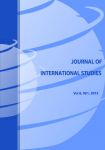EFFICIENCY MEASUREMENT OF NATIONAL INNOVATION SYSTEMS OF THE EUROPEAN UNION COUNTRIES: DEA MODEL APPLICATION
EFFICIENCY MEASUREMENT OF NATIONAL INNOVATION SYSTEMS OF THE EUROPEAN UNION COUNTRIES: DEA MODEL APPLICATION
Author(s): Eva Juřičková, Michal Pilik, Michael Adu KwartengSubject(s): Methodology and research technology, Economic development, EU-Approach / EU-Accession / EU-Development
Published by: Fundacja Centrum Badań Socjologicznych
Keywords: data envelopment analysis; National Innovation System; technical efficiency; innovation performance;
Summary/Abstract: This paper focuses on measuring technical efficiency of National Innovation System across a sample of the European Union (EU) countries using data envelopment analysis. We used an output-oriented constant returns to scale model to calculate the efficiency of the units represented by the European Union countries. This nonparametric method measures efficiency of input utilisation as compared to the achieved outputs during the consumption process. Following previous studies on this topic, we have used the number of researchers and the expenditures on research and development (R&D) as inputs and published scientific journal articles and applied patents as outputs of the model. Stemming from the available data, we have covered the period of 2005–2016. This period covers the economic period before the financial crisis and economic recession in which it was necessary to use resources effectively for the maximisation of final production. The study also presents data representing the era of growth trend in European economy. The only efficient countries in our study as of 2016 were found to be Cyprus, Luxembourg, Malta, and Romania. The number of efficient units decreased from six countries measured in 2005 from among the eight calculated in the years of the economic crisis to four efficient decision-making units (DMUs) in 2015. Germany, the best performer in the European Union with respect to patent rankings, was classified as an inefficient unit with a 0.50 efficiency scale. The results indicate differences between the innovation performance investigated by various indices available in public databases and the DEA technical efficiency. The best performers can be considered as inefficient in the utilisation of resources entering the National Innovation System (NIS) for which
Journal: Journal of International Studies
- Issue Year: 12/2019
- Issue No: 4
- Page Range: 286-299
- Page Count: 14
- Language: English

